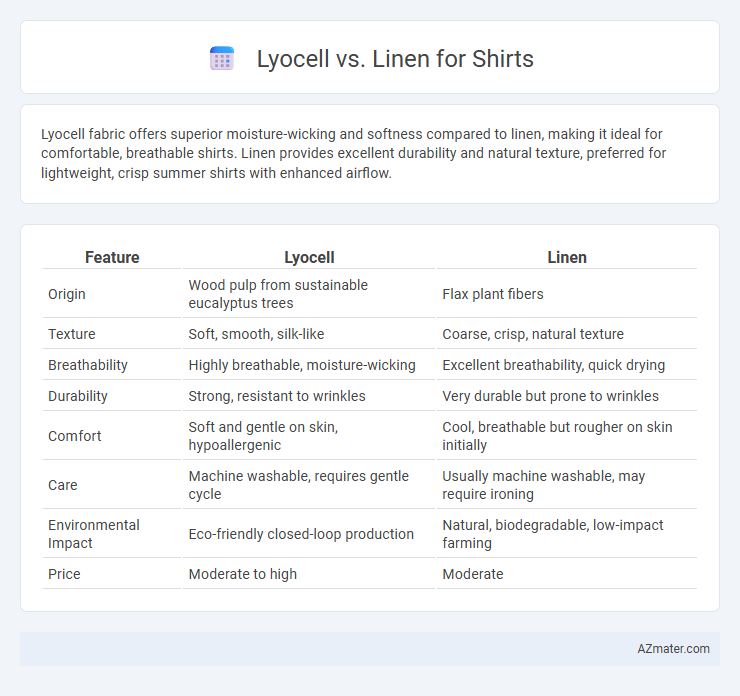Lyocell fabric offers superior moisture-wicking and softness compared to linen, making it ideal for comfortable, breathable shirts. Linen provides excellent durability and natural texture, preferred for lightweight, crisp summer shirts with enhanced airflow.
Table of Comparison
| Feature | Lyocell | Linen |
|---|---|---|
| Origin | Wood pulp from sustainable eucalyptus trees | Flax plant fibers |
| Texture | Soft, smooth, silk-like | Coarse, crisp, natural texture |
| Breathability | Highly breathable, moisture-wicking | Excellent breathability, quick drying |
| Durability | Strong, resistant to wrinkles | Very durable but prone to wrinkles |
| Comfort | Soft and gentle on skin, hypoallergenic | Cool, breathable but rougher on skin initially |
| Care | Machine washable, requires gentle cycle | Usually machine washable, may require ironing |
| Environmental Impact | Eco-friendly closed-loop production | Natural, biodegradable, low-impact farming |
| Price | Moderate to high | Moderate |
Introduction to Lyocell and Linen Fabrics
Lyocell, a sustainable fabric made from wood pulp, offers exceptional softness, breathability, and moisture-wicking properties, making it ideal for shirts. Linen, derived from the flax plant, is renowned for its durability, natural texture, and excellent breathability, providing a crisp, lightweight feel perfect for warm climates. Both fabrics are eco-friendly choices, with Lyocell featuring a closed-loop production process, while linen requires minimal water and pesticides during cultivation.
Origins and Manufacturing Processes
Lyocell is a semi-synthetic fiber derived from sustainably sourced wood pulp, primarily eucalyptus, processed through a closed-loop system that recycles water and solvents to minimize environmental impact. Linen, composed of natural flax fibers, undergoes a traditional retting process to extract fibers from flax stalks, involving soaking and drying steps that are labor-intensive but eco-friendly. Both materials reflect distinct origins and manufacturing techniques influencing their sustainability profiles and fabric characteristics.
Sustainability and Environmental Impact
Lyocell fibers are derived from sustainably sourced wood pulp and manufactured through a closed-loop process that recycles water and solvents, significantly reducing environmental impact compared to traditional textiles. Linen, made from flax plants, requires minimal water and pesticides, offering a natural and biodegradable option with low ecological footprint. Both fabrics promote sustainability, but Lyocell's eco-friendly production technology and biodegradable properties make it a leading choice for environmentally conscious shirt manufacturing.
Breathability and Comfort Comparison
Lyocell offers superior breathability due to its moisture-wicking properties, making it highly comfortable for warm weather and active wear. Linen, made from flax fibers, provides excellent ventilation and a natural cooling effect but tends to wrinkle easily, affecting long-term comfort. Both fabrics are breathable, yet Lyocell's softness and smooth texture deliver enhanced comfort, while linen excels in durability and a crisp, airy feel.
Moisture Wicking and Absorption Qualities
Lyocell fabric excels in moisture wicking due to its highly absorbent cellulose fibers that draw moisture away from the skin, keeping the wearer dry and comfortable. Linen, derived from flax fibers, also offers excellent moisture absorption but tends to dry faster, making it ideal for hot and humid conditions. Both materials provide breathable properties, yet Lyocell's smooth texture enhances moisture management, while linen's natural fiber structure improves airflow and quick drying for optimal comfort in shirts.
Durability and Longevity
Lyocell, a semi-synthetic fiber made from sustainably sourced wood pulp, offers exceptional strength and resistance to wear, making it highly durable for shirts. Linen, derived from flax fibers, is renowned for its natural toughness and long-lasting qualities, often improving with each wash due to its strong fiber structure. While both materials provide excellent longevity, lyocell resists shrinking and maintains shape better, whereas linen excels in breathability and becomes softer over time.
Care and Maintenance Requirements
Lyocell shirts require gentle washing in cold water and air drying to maintain their softness and avoid shrinkage, with minimal wrinkling reducing the need for frequent ironing. Linen shirts, while breathable and durable, demand careful hand washing or machine washing on a delicate cycle, followed by line drying to prevent fiber damage, with ironing often necessary to smooth wrinkles. Both fabrics benefit from avoiding harsh detergents and bleach, but Lyocell generally offers easier maintenance due to its resistance to wrinkles and fading.
Texture and Appearance Differences
Lyocell fabric offers a smooth, silky texture with a subtle sheen that enhances its modern, polished appearance, making it ideal for sleek, luxurious shirts. Linen, in contrast, features a coarser, more textured weave with visible slubs, providing a natural, rustic look characterized by breathability and casual elegance. The distinct tactile qualities and visual irregularities of linen create a relaxed aesthetic, while lyocell's uniform finish lends itself to a refined, sophisticated style.
Ideal Use Cases for Shirts
Lyocell shirts excel in moisture-wicking and breathability, making them ideal for active or warm-weather use, offering a soft and smooth texture that enhances comfort. Linen shirts provide excellent durability and a naturally textured, crisp feel, perfect for casual, relaxed settings or hot climates due to their superior airflow and quick-drying properties. Both fabrics support eco-friendly fashion choices, with Lyocell made from sustainably sourced wood pulp and linen derived from flax plants, suitable for conscious consumers seeking breathable, lightweight shirts.
Cost and Value Considerations
Lyocell shirts typically carry a higher price due to their environmentally friendly production process and superior moisture-wicking properties. Linen shirts, while often more affordable, offer durability and breathability that improve with wear, providing long-term value. Choosing between Lyocell and linen depends on balancing upfront cost with preferences for sustainability, comfort, and fabric longevity.

Infographic: Lyocell vs Linen for Shirt
 azmater.com
azmater.com